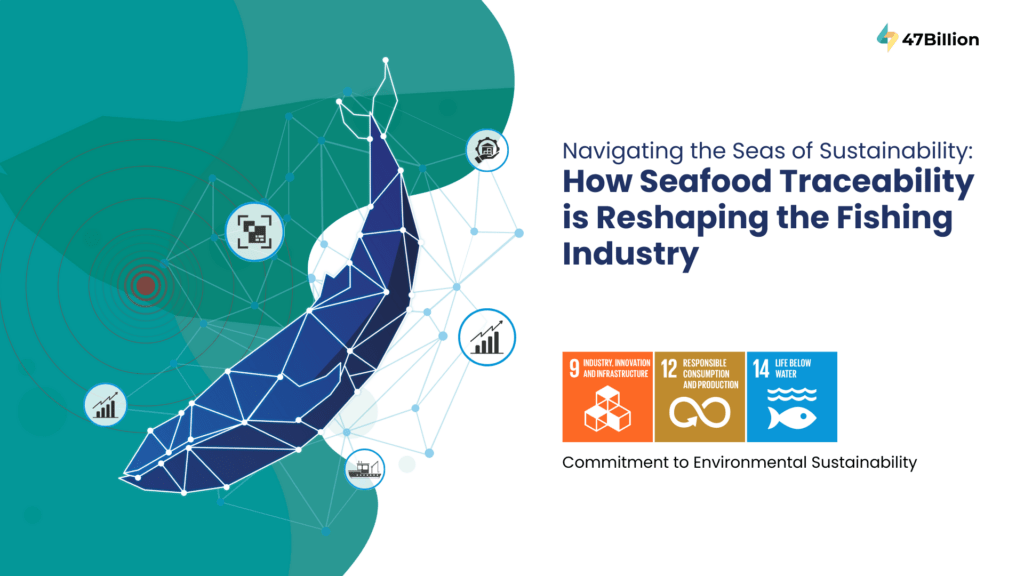Table of Contents –
· Introduction
· What is Seafood Traceability?
· Key factors shaping the growth of seafood traceability
· What is a traceability system?
· Complete supply chain functionality
· Digital Framework
· Nurturing a responsible and transparent seafood industry
Introduction
Do you know that 6 billion tons of fish and other invertebrates from seas have been extracted since 1950?
Are you aware that more than 3 billion people worldwide were affected by this loss?
Do you know that overfishing in Southeast Pacific and Southwest Atlantic affects more than 58% of the fish population that inhabit them?
The silence of the oceans is disturbed by these rippling secrets that are resulting in the extinction of the underwater world.
Seafood has always been a major source of nourishment, that provides sustenance to people worldwide.
The seafood industry is among the world’s largest and oldest sectors.
It ranges from traditional fishing in open-water areas to inland aquaculture farming and recreational angling.
The industry is looking forward to revolutionizing and at the same time, it’s plagued by malpractices and poor fisheries management. The three primary forms of malpractices – overfishing, illegal, unreported, and unregulated (IUU) fishing, and Bycatch
These malpractices destroy delicate marine habitats and distort competition.
Of all three, overfishing takes the biggest toll on marine life.
It not only affects the seafood that is consumed but also creates imbalances in the marine ecosystem.
IUU fishing leads to the depletion of fish stocks, it affects the balance of the marine ecosystem and ends up endangering the long-term survival of fisheries and local fishing communities. Bycatch is catching unwanted species while fishing for a particular species of fish. It puts the population of other marine life at risk.
Therefore, to counteract these malpractices, the demand for sustainable operations has risen globally.
From time to time, companies have made sustainability claims concerning their products along with environmental benefits.
Traditionally these claims were supposedly backed by seafood audits, but only a small sample of suppliers was actually audited.
Due to increased consumer awareness and the need to validate sustainable practices, seafood traceability has become paramount.
Traceability helps verify the authenticity of the food item from the origin. It helps in validating the sustainability efforts of the producer.
But these industry malpractices including mislabeling and illegal fishing continue on a large scale.
Thus, transparency throughout the seafood supply chain is important as it ensures fish’s legality, sustainability, and ethical sourcing. Traceability enables consumers to make informed choices, supports fisheries management, and encourages industry accountability, ultimately driving the demand for sustainable seafood.
What is Seafood Traceability?
Seafood traceability refers to tracking and documenting the journey of seafood from its origin, such as fishing vessels or aquaculture farms, including various processing stages, distribution, and ultimately to the end consumer. It involves capturing and recording essential information about the fish, including species, catch location, fishing method, and other relevant data.
Traceability systems enable the ability to trace the entire supply chain, ensuring industry transparency, authenticity, and accountability. By providing a detailed record of the fish’s journey, traceability helps verify the legality, sustainability, and quality of seafood products, addressing concerns related to food safety, environmental impact, and responsible
Key factors shaping the Growth of Seafood Traceability

Sustainability and Conservation: Fish traceability enables fish tracking from their source to the market, ensuring that seafood is sourced responsibly, leading to the reduction of overfishing practices and the conservation of marine ecosystems for future generations.
- Consumer Demand and Trust: Allows consumers to make informed choices, verify the sustainability claims of seafood products, and build trust in the industry.
- Food Safety and Quality Assurance: Traceability enhances food safety by enabling swift identification and targeted recalls in case of contamination or other risks. It ensures that seafood products meet regulatory standards and quality assurance measures, protecting public health and maintaining consumer confidence.
- Illegal, Unreported, and Unregulated (IUU) Fishing: By capturing data on catch locations, fishing vessels, and licenses, traceability helps verify the legality of seafood products and reduces the market for illegally sourced fish.
- Supply Chain Management and Efficiency: Traceability supports better supply chain management, facilitating optimized inventory control, efficient logistics, and timely deliveries. It improves overall operational efficiency, reduces waste, and ensures the integrity of the seafood supply chain.
- Compliance with Regulations and Standards: Many regulations and sustainability standards require traceability as a certification or market access prerequisite. Compliance with these requirements ensures fisheries and seafood businesses meet legal obligations and adhere to responsible practices.
- Traceability Technologies and Innovations: Advancements in technology, such as barcoding, RFID tagging, and blockchain, have made fish traceability more accurate, efficient, and accessible. These innovations enable real-time data capture, seamless information sharing, and secure record-keeping, revolutionizing traceability practices.
What is a Traceability System?
A traceability system is a comprehensive and integrated set of processes, technologies, and protocols that enable the tracking and documentation of fish and seafood products throughout the entire supply chain. It involves capturing and recording relevant information at each stage, including catch locations, fishing vessels, processing facilities, distributors, and retail points. This system aims to provide transparency and accountability, ensuring the traceability of fish from its origin to the consumer. By leveraging various technologies, the traceability system helps verify the legality, sustainability, and quality of seafood products, addressing food safety, environmental impact, and responsible sourcing concerns.
Complete Supply Chain Functionality

It is an interconnected network of processes, activities, and stakeholders that track and document fish from its source to the end consumer. It encompasses all the stages and entities involved in the movement of fish products.
Fish Capture/Harvest: The catching or harvesting of fish from oceans, rivers, or aquaculture farms.
Vessels/Boats: The fishing vessels or boats that capture the fish are equipped with tracking technologies to monitor their location and activities.
Fishing Sites: The areas where fishing activities are prevalent include offshore areas, coastal regions, or designated fishing zones.
Fishers: The individuals involved in catching or harvesting the fish, including commercial fishermen, small-scale fishers, or aquaculture farmers.
Cooperatives: The Organizations or associations that support fishers by providing resources, facilities, or marketing services. They play a role in aggregating and organizing fish from multiple fishers.
Traceability Records: The collection and documentation of data and information related to fish, such as species, quantity, location, catch methods, and timestamps. This information provides a traceable record of the fish throughout the supply chain.
Inventories: The maintenance of two inventories—raw fish and processed fish inventory—to keep track of the fish at different stages, from raw catch to processed products.
Order Management: Managing orders placed by cooperatives, processing centers, or clients, including internal orders within the cooperative and external orders to processing centers or clients.
Transportation: Transporting fish from the cooperative or processing center to the receiver or client, ensuring proper handling and preservation of the fish.
Processing Centers: Facilities where the raw fish undergo processing, which may include cleaning, filleting, freezing, packaging, or value-added processing.
Order Traceability: The ability to track and trace individual orders throughout the supply chain, ensuring that each order is appropriately accounted for and can be monitored from its origin to the final delivery.
Secure Transitions: The implementation of security measures such as OTP verification (One-Time Password) to ensure the safety and integrity of the fish and order transitions.
Digital Framework
Developing a web application that supports the sustainability of fishing and enables fish traceability and order management brings significant digital advancements to the industry. The application enhances transparency and accountability in the fishing process by leveraging technology to track fish records, fishers, vessels, fishing sites, and cooperatives. The maintenance of two inventories, one for raw fish and another for processed fish, streamlines operations and ensures efficient inventory management.
- The platforms help simplify fish transportation for both the cooperative and its clients. It optimizes logistics, reducing the time and effort required for delivery.
- The categorization of orders into internal (within the cooperative) and external (to the processing center) allows for streamlined order management, ensuring smooth coordination between different entities.
- The emphasis on order traceability and secure delivery through OTP verification adds trust and security to the system. This feature enhances customer confidence and enables effective tracking of orders throughout the supply chain.
- The integration of text message notifications for fishers upon catching a fish facilitates timely communication and enables prompt processing.
- The integration of email functionality using SendGrid enhances communication capabilities, allowing for seamless interactions between stakeholders, such as cooperatives, processing centers, and clients. This feature enables efficient order updates, notifications, and overall communication management.
Nurturing a Responsible and Transparent Seafood Industry
Consequently, the fishing industry faces substantial transparency, traceability, and order management challenges. Limited supply chain visibility and outdated record-keeping systems hinder efficient tracking and management. However, embracing traceability solutions is crucial for promoting responsible fishing practices and meeting the growing consumer demand for sustainable seafood. By enhancing transparency, traceability fosters industry accountability and empowers consumers to make informed choices, ensuring the legality and sustainability of fish products. Technological advancements offer promising solutions for optimizing traceability and order management processes in the fishing industry.
47Billion is glad to announce an enhanced business strategy formulated to maximize the combined impact of its technologies, solutions, and capabilities to address some of the biggest global challenges and support the UN Sustainability Development Goals.
Read related articles –
47Billion Is Taking UN Sustainability Goals To The Next Level Of Impact
Vertical Farming: Harnessing Technology For Sustainable Agriculture
Water Trading: Paving The Way For Sustainable Conservation In California’s Drought Zones







